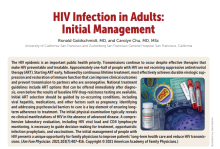
The HIV epidemic is an important public health priority. Transmissions continue to occur despite effective therapies that make HIV preventable and treatable. Approximately one-half of people with HIV are not receiving suppressive antiretroviral therapy (ART). Starting ART early, followed by continuous lifetime treatment, most effectively achieves durable virologic suppression and restoration of immune function that can improve clinical outcomes and prevent transmission to partners who are seronegative. National treatment guidelines include ART options that can be offered immediately after diagnosis, even before the results of baseline HIV drug-resistance testing are available. Initial ART selection should be guided by co-occurring conditions, including viral hepatitis, medications, and other factors such as pregnancy. Identifying and addressing psychosocial barriers to care is a key element of ensuring long-term adherence to treatment. The initial physical examination typically reveals no clinical manifestations of HIV in the absence of advanced disease. A comprehensive laboratory evaluation, including HIV viral load and CD4 lymphocyte monitoring, is necessary to guide decision-making for treatment, opportunistic infection prophylaxis, and vaccinations. The initial management of people with HIV presents a unique opportunity for family physicians to improve patients' long-term health care and reduce HIV transmissions.
Goldschmidt R, Chu C. HIV Infection in Adults: Initial Management. Am Fam Physician. 2021 Apr 1;103(7):407-416. PMID: 33788514.